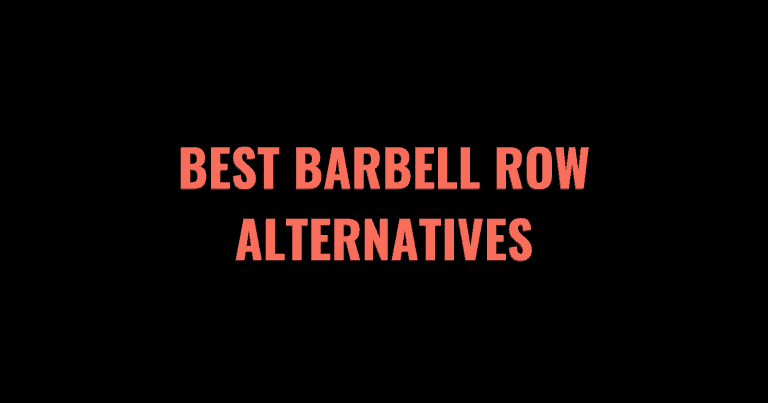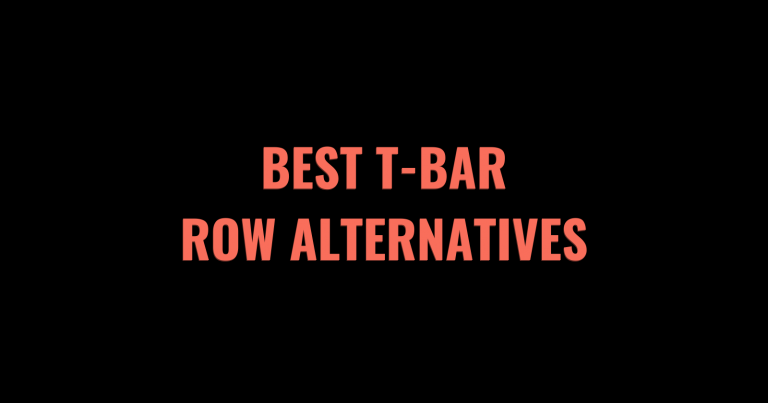The incline bench press is a classic bodybuilding exercise that builds size and strength in your upper chest muscles. Bench pressing on an incline bench emphasizes the clavicular head of the pectoralis major, the largest muscle in your chest. Building a fuller, rounder upper chest creates an impressive upper body physique. But not everyone has access to the equipment needed for incline bench presses, while others simply don’t enjoy the movement. Here is our list of the best alternative exercises to incline bench presses to build upper body strength and a bigger, fuller upper chest.
Table of Contents
- 1 The 8 Best Incline Bench Press Alternatives
- 2 1. Incline Dumbbell Presses
- 3 2. Decline Push-Ups
- 4 3. Incline Floor Presses
- 5 4. Dumbbell Chest Pullovers
- 6 5. Reverse Grip Rotational Dumbbell Floor Presses
- 7 6. Low-to-High Cable Flyes
- 8 7. Resistance Band Incline Chest Presses
- 9 8. Underhand Chest Front Raises
- 10 Reasons to Choose an Incline Bench Press Alternative
- 11 Muscles Worked by Incline Bench Presses
- 12 FAQs
- 13 Other Alternative Exercises
- 13.1 The 9 Best Pendlay Row Alternatives
- 13.2 The 10 Best Leg Extension Alternatives
- 13.3 The 10 Best Glute Bridge Alternatives
- 13.4 The 10 Best Overhead Press Alternatives
- 13.5 The 10 Best Plank Alternatives
- 13.6 The 9 Best Barbell Row Alternatives
- 13.7 The 12 Best Pull-Up Alternatives
- 13.8 The 8 Best Ab Rollout Alternatives
- 13.9 The 8 Best Decline Bench Press Alternatives
- 13.10 The 10 Best Bench Press Alternatives
- 13.11 The 9 Best T-Bar Row Alternatives
- 13.12 The 10 Best Dumbbell Pullover Alternatives
- 13.13 The 10 Best Bent Over Row Alternatives
- 13.14 The 10 Best Pallof Press Alternatives
- 13.15 The 10 Best Lying Leg Curl Alternatives
The 8 Best Incline Bench Press Alternatives
- Incline Dumbbell Presses
- Decline Push Ups
- Incline Floor Presses
- Dumbbell Chest Pullovers
- Reverse Grip Rotational Dumbbell Presses
- Low to High Cable Flyes
- Resistance Band Incline Chest Presses
- Underhand Chest Front Raises
1. Incline Dumbbell Presses
If you have access to an incline bench but don’t enjoy pressing a barbell, this is the alternative for you. Incline dumbbell presses are the closest alternative to standard incline barbell bench presses. They activate the same muscle groups but are more comfortable for some lifters as they allow more natural wrist and shoulder movement. When pressing with dumbbells, the weight moves up and inward, moving the chest muscles through a fuller range of motion.
How to Perform Incline Dumbbell Presses
- Adjust a bench so that it is at a 30-degree incline. Lay down on the bench and firmly plant your feet for support and stability.
- Hold the dumbbells with an overhand grip just above your chest. Retract your shoulder blades and brace your abdominals by taking a deep inhale. Start every rep from this position.
- Exhale. Squeeze your chest muscles to extend your arms until the dumbbells are directly above your upper chest.
- Reverse the movement by bending your elbows and slowly pulling the dumbbells back to hover just above your pecs.
- Repeat for the desired number of sets and reps.
This video from Scott Herman Fitness provides a helpful visual guide for performing incline dumbbell presses.
Tips for Incline Dumbbell Presses
To do this exercise without a bench, you can lay on a stability ball or foam roller to create an incline. Aim for as close to 30 degrees as possible with the available equipment to emphasize the upper pecs most effectively. Keep your elbows tucked close to your body to avoid straining your chest and shoulder tendons.
2. Decline Push-Ups
When to Perform Decline Push-Ups
Decline push-ups are the best way to target your upper chest using only your bodyweight. Elevating your feet on a platform increases the tension on your upper pecs and anterior deltoid without needing any weights or a bench. Decline push-ups are a great exercise for days when the benches are all taken, or while training from home or on travel.
How to Perform Decline Push Ups
- Assume a plank position with your feet elevated on a box, bench, or piece of furniture. Ensure the platform is stable, can support your weight, and is an appropriate height for your strength level.
- Brace your abdominals, retract your shoulder blades, and tuck your chin to keep a neutral spine. Your body should form a straight diagonal line from your head to your heels.
- Ensure your wrists are stacked right under your shoulders and the balls of your feet dig firmly into the platform.
- Bend your elbows to lower your body towards the ground. Keep your elbows tucked close to the body.
- Pause when your chest hovers an inch or two above your hands, and you feel the tension in your upper pecs.
- Squeeze your chest and push through your triceps to return to the starting position in a plank.
- Repeat for the desired number of sets and reps.
For a visual aid, check out this video from PureGym.
Tips for Decline Push Ups
Start with a lower platform as you get used to this exercise. Increase the platform height as your strength increases to further challenge your upper body strength. Inhale as you lower your body to the ground and exhale as you press your bodyweight back up.
3. Incline Floor Presses
When to Perform Incline Floor Presses
Floor presses are a useful, minimal-equipment alternative to bench presses. You can introduce an incline to floor presses by lying on a stability ball, folded up gym mat, or a stack of rolled-up towels. Elevating the torso about 30 degrees from the floor increases the range of motion and effectively targets your upper chest. You can do incline floor presses using barbells or dumbbells, depending on what equipment you have available and your preference.
How to Perform Incline Floor Presses
- Lie on a stability ball or other platform that positions your torso at a 30-degree incline.
- Hold a pair of dumbbells (or a barbell) with an overhand grip directly above your chest.
- Press the weight above your chest until your elbows are extended, and the dumbbells or barbell is in line with your nipples.
- Slowly lower the weight back towards you until it hovers an inch or two off your upper chest.
- Repeat for the desired number of sets and reps.
Check out this video from Scott Herman Fitness for a visual guide to performing the incline dumbbell press using a stability ball.
Tips for Incline Floor Presses
Using a stability ball instead of a bench requires more stabilization from your core muscles. Ensure you are able to brace your abdominals to keep your torso stationary as you press the weight above your chest. If using rolled-up mats or towels, be consistent with the height of your DIY incline platform to target the correct muscle groups each time.
4. Dumbbell Chest Pullovers
When to Perform Dumbbell Chest Pullovers
Dumbbell pullovers work the pec muscles through a wide arc, stretching and contracting them effectively. However, dumbbell pullovers are not a perfect alternative to incline bench presses because they don’t isolate the upper chest. They target your pecs, serratus anterior, and lats. They also engage the delts, triceps and biceps to a lesser degree, contributing to a stronger and bigger overall chest. Dumbbell pullovers are a convenient and efficient exercise because they target several muscle groups in the upper body and only require a single dumbbell.
How to Perform Dumbbell Chest Pullovers
- Lie down on a flat bench or the ground with a single dumbbell held in both your hands.
- Hold the dumbbell above your chest with a slight bend in your elbows. Pull your shoulder blades back and down and brace your core.
- Lower the dumbbell behind your head until your arms are parallel to the ground and you feel a stretch in your lower pecs.
- Squeeze your chest and lats to pull the dumbbell back to its starting position above your chest.
- Repeat for the desired number of sets and reps.
Check out this video from Colossus Fitness for a visual guide to performing the dumbbell chest pullover.
Tips for Dumbbell Chest Pullovers
Keep your elbows slightly bent throughout this exercise, but don’t bend them more as your arms move overhead. Bending the elbows excessively emphasizes triceps similarly to a skull crusher. Performing this exercise with bent elbows will be less effective at isolating your pecs.
5. Reverse Grip Rotational Dumbbell Floor Presses
When to Perform Reverse Grip Rotational Dumbbell Presses
If you want to target your upper pecs without an incline bench, this is the exercise for you. Reversing your grip emphasizes your upper chest even more effectively than a standard grip incline bench press. This variation forces the elbows to remain tucked and recruits more muscles in the upper chest and anterior deltoid.
How to Perform Reverse Grip Rotational Dumbbell Presses
- Lie on a flat bench or the ground holding a dumbbell in each hand. Use a neutral grip but rotate your wrists outward by about 45 degrees.
- Press the dumbbells directly above your chest while continuing to rotate the wrists. Squeeze your chest muscles on the ascent.
- Stop when your arms are extended, and your hands are fully supinated. Your palms should face inward, and the ends of the dumbbells should touch each other.
- Slowly reverse the movement by bending your elbows and allowing your wrists to rotate back to a neutral position.
- Repeat for the desired number of sets and reps.
This video from Jim Stoppani, PhD provides a great overview of how to use reverse grip rotational dumbbell presses to target your upper chest.
Tips for Reverse Grip Rotational Dumbbell Presses
Using a reverse grip feels unnatural for many lifters. For some, this grip leads to wrist strain or reduced control over the weight. Start with a lighter weight than you would normally use while your wrists and grip strength grows accustomed to the new movement pattern.
6. Low-to-High Cable Flyes
When to Perform Low-to-High Cable Flyes
Low-to-high cable flyes are an excellent alternative to incline bench presses. The upper chest muscles are primarily involved in flexion and horizontal adduction of the shoulder. Low-to-high cable flyes move the upper pecs through a greater range of motion and involve more flexion and adduction than a standard bench press. This exercise is great for mimicking the pull of the clavicular head of the pectoral major, building a bigger, fuller upper chest.
How to Perform Low-to-High Cable Flyes
- Stand in front of a dual cable tower. Attach a single handle to the lowest pulley position.
- Grab a handle in each hand and face away from the cable station. Keep your palms facing forward and hold your upper arms about 30 degrees away from your torso.
- Brace your abdominals and maintain a neutral spine throughout your set.
- Squeeze your upper pecs to pull the cable handles up and towards each other. The movement arc should resemble an inverted V shape.
- Slowly reverse the movement by lowering the cable handles down to your sides. Stop when your arms are extended but not locked out, and you can feel your pecs stretch.
- Repeat for the desired number of sets and reps.
For a visual guide to low-to-high cable flyes, check out this video from Testosterone Nation.
Tips for Performing Low-to-High Cable Flyes
Maintain a soft bend in your elbows throughout this exercise. Actively squeeze your chest muscles to initiate the movement and ensure you feel your upper pecs stretch in between each rep. Keep your wrists aligned with your forearms, and be careful not to grip the handles too tightly. Gripping the handles too tightly recruits the forearm flexors and biceps, reducing the effectiveness for your upper chest.
7. Resistance Band Incline Chest Presses
When to Perform Resistance Band Incline Chest Presses
Resistance band incline chest presses are a useful alternative to incline bench presses that require minimal equipment. Attaching a long loop resistance band to a low door anchor mimics the upward diagonal motion of an incline chest press. Resistance band incline chest presses place the chest muscles under constant tension, recruiting more muscle fibers the further you push your hands from your chest.
How to Perform Resistance Band Incline Chest Presses
- Attach a long loop resistance band to a low door anchor. You can also loop it around the leg of a sturdy couch or bed.
- Face away from the anchor. Take a few steps forward to create some tension in the band. Stagger your stance for more stability.
- Step inside the loop of the band and grab it with both hands. Use an overhand grip and position your hands just outside shoulder width.
- Pull your shoulder blades back and down. Tuck your chin and gaze forward. Brace your abdominals and leg muscles to resist the force of the band pulling you backwards.
- Push your hands out and up at a 45-degree angle. Squeeze your chest muscles to bring your hands together at the top of the movement.
- Pause when your arms are fully extended, and you feel your upper pecs contracting.
- Slowly reverse the movement. Bend your elbows and bring your hands just in front of your chest.
- Repeat for the desired number of sets and reps.
For a visual guide to resistance band incline chest presses, check out this video from Bodylastics.
Tips for Performing Resistance Band Incline Chest Presses
To increase the tension in your resistance band, step further away from the anchor. You can also achieve greater muscle activation by adding a 1-2 second pause at the top of the movement when your arm is extended. Increasing time under tension creates more metabolic stress, leading to superior strength and hypertrophy gains.
8. Underhand Chest Front Raises
When to Perform Underhand Chest Front Raises
Dumbbell front raises are usually considered a delt exercise. By changing the grip so that your palms face outward, you shift the emphasis to your upper pecs. Underhand front raises work your shoulders, triceps, and biceps, and chest. This exercise is particularly good at eccentrically loading the upper pecs as the elbows lower in front of the body.
How to Perform Underhand Chest Front Raises
- Stand tall with a dumbbell in each hand. Retract your shoulder blades and rotate your arms so that your palms face outward.
- Keep your shoulder blades down and lift your arms out in front of you. Keep a slight bend in your elbows to minimize bicep engagement and emphasize your chest.
- Stop when the dumbbells are aligned with your shoulders, and you feel your upper pecs contract.
- Slowly return the dumbbells to rest near your quads.
- Repeat for the desired number of sets and reps.
For a visual guide to underhand chest front raises, check out this video from Unjaded Fitness.
Tips for Performing Underhand Chest Front Raises
Move the dumbbells through an arc so that your arms move closer together at the end of each rep. Following this movement path will engage more muscles in the upper pecs and anterior deltoid.
Reasons to Choose an Incline Bench Press Alternative
Electromyographical (EMG) studies have found bench presses at a 30-degree incline more effectively recruit the upper pecs. Effective alternatives to incline bench presses should emphasize the same primary muscle group: the upper pectoral muscles. Incline bench press alternatives should ideally also recruit the anterior deltoids and lats. Some reasons you may seek an alternative to the incline bench press include:
- You don’t have access to an incline bench and/or a barbell.
- Incline bench presses cause shoulder pain.
- You aren’t seeing the results you hoped for with incline bench presses.
- You have reached a training plateau and want to vary your exercise selection.
- You want exercises that you can do from home or while traveling.
Muscles Worked by Incline Bench Presses
Incline bench presses primarily target the upper section (clavicular head) of your pectoralis major. Your triceps and anterior deltoid are also involved. Your abdominals and upper back muscles play a minor role in assisting and stabilizing your upper body during the lift.
- Primary muscles used: Pectoralis Major (Upper), Anterior Deltoid
- Secondary muscles used: Triceps
- Assisting/stabilizing muscles: Latissimus Dorsi, Abdominals
FAQs
No. Chest exercises, like the incline bench press, recruit your entire chest to lift the weight. However, incline bench presses engage more muscle fibers in your upper pectoralis major compared to decline or flat bench presses. Performing bench presses with your bench at a 30-degree incline is one of the most effective ways to build size and strength in your upper chest area.
For more information, check out our article on how to grow your upper chest.
There are plenty of low equipment options for working the clavicular head of the pectoral major. Decline push-ups elevate your feet, further emphasizing your upper chest and anterior delts. Alternatively, you can target your upper chest without a bench by doing dumbbell pullovers, or by using a stability ball, foam roller, or a stack of folded towels as a substitute for an incline bench.
Other Alternative Exercises
If you enjoyed this post, check out our other roundups of the best alternatives for other exercises.













